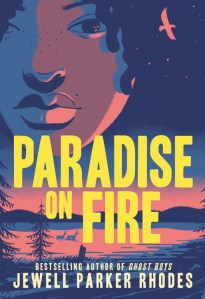Jewell Parker Rhodes on PARADISE ON FIRE

Paradise on Fire was inspired by African American teens I met while giving a speech for the Jackson Hole Writers Conference. The audience was majority white and after my speech, I reached out to everyone, but especially the six or so black youth. I learned they were part of City Kids, a Washington, DC, program that mentors youth and runs a summer wilderness program in Wyoming. From my own experience, I knew that many city youth never experience national parks, never learn camping and hiking skills, and never learn to swim and enjoy water sports. Only as an adult did I realize the beauty and healing power of nature.
Inspired by the hugely deadly and destructive 2018 Camp Fire, I created six urban characters who struggle to survive a terrain of fire, smoke, and a desperate flight down raging waters.
It is Addy (short for Aduago, “daughter of the eagles”) who draws on her inner strength, spiritual sense, and street smarts to inspire her campmates and save them.
Addy represents all the young girls—campers, Girl Scouts, etcetera, who learn resilience and leadership skills. Addy also learns the power of community, risk-taking, and her inner strength.
Like most of my character creations, Addy came to me in a dream. The Paradise on Fire cover art captures her steadfast, watchful gaze and her inner and outer beauty. I love the glowing specks of firelight in her eyes. I, love, too, the eagle soaring high above her.
To my chagrin, Addy loved maps and mazes. (Something I had to research-in-depth!) Yet, her ability to see, especially from an aerial perspective and to draw in 3-D, demonstrated her natural intuitive, scientific, and geographical abilities.
Addy represents all kids who because of limited horizons, never get to discover other gifts they might have. Addy, by learning about global warming and climate change, makes a commitment to become an environmentalist.
Minority visitation to national parks is unbelievably low. Science has demonstrated how even minimal access to nature is good for human happiness and health. Yet, also, how does the next generation learn to understand and care about climate, if they don’t see the real-time, real-life effects on humans, animals, and the environs? Young people need to know that ninety-seven percent of wildfires are started by people. This means then that all people—most, notably the next generation, have the power and advocacy to make environmental change.
Addy is brave, deeply emotional and is a survivalist companion of Brian in Gary Paulsen’s Hatchet. Yet Addy isn’t a sole survivor. She is the girl that wins the respect of her companions and fights beyond measure, to save them. In appreciating the natural world, she becomes one of its’ champions.
Addy is haunted by the tragic fire that killed her parents, leaving her to be raised by her grandmother. Years later, Addy’s grandmother has enrolled her in a summer wilderness program. There, Addy joins five other Black city kids—each with their own troubles—to spend a summer out west.
Deep in the forest the kids learn new (and to them) strange skills: camping, hiking, rock climbing, and how to start and safely put out campfires. Most important, they learn to depend upon each other for companionship and survival.
But then comes a devastating forest fire…
Addy is face-to-face with her destiny and haunting past. Developing her courage and resiliency against the raging fire, it’s up to Addy to lead her friends to safety. Not all are saved. But remembering her origins and grandmother’s teachings, she’s able to use street smarts, wilderness skills, and her spiritual intuition to survive.
BCALA 2021 Best of the Best Book
A Cadmus Children’s Fiction Award for the Green Earth Book Award winner
